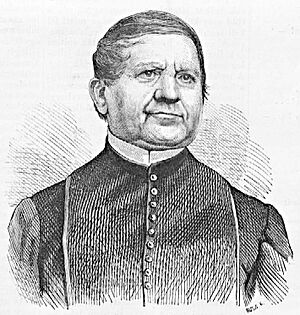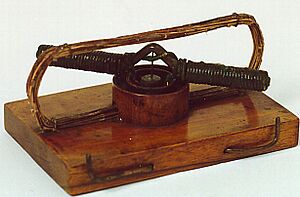Ányos Jedlik facts for kids
Quick facts for kids
Ányos István Jedlik
|
|
|---|---|

Portrait by Károly Rusz, 1866
|
|
| Born |
Jedlik Ányos István
11 January 1800 Szimő, Kingdom of Hungary (today Zemné, Slovakia)
|
| Died | 13 December 1895 (aged 95) |
| Citizenship | Hungarian |
| Known for | Electric motor, dynamo, self-excitation, impulse generator, Cascade connection |
| Scientific career | |
| Fields | Inventor, engineer, physicist |
Ányos István Jedlik was a Hungarian inventor, engineer, and physicist. He was also a Benedictine priest. Many people consider him the "unsung father" of the dynamo and electric motor. He was a member of the Hungarian Academy of Sciences and wrote many books.
Jedlik's Life and Work
Ányos István Jedlik was born on January 11, 1800, in Szimő, which was part of the Kingdom of Hungary. Today, this place is called Zemné and is in Slovakia. His parents were Ferenc Jedlik and Rozália Szabó.
Early Life and Education
Jedlik started his schooling in Nagyszombat (now Trnava) and Pozsony (now Bratislava). In 1817, he joined the Benedictine order. He continued his studies in Győr, where he focused on humanities.
He earned a doctorate in 1822 in Pest. He passed exams in subjects like mathematics, physics, and philosophy. In 1825, he became a priest.
Teaching and Inventions
The Benedictine order decided that Jedlik should teach. He taught at the grammar school in Győr. There, he often made his own tools and created his first inventions. From 1831, he taught at the Royal Academy in Pozsony.
In 1840, he became a physics professor at the Budapest University of Sciences. He helped train a new generation of physicists. He was the dean of the Faculty of Arts in 1848. By 1863, he became the university's rector.
Jedlik was also a member of the Hungarian Academy of Sciences. He retired from teaching but kept working on his inventions. He spent his last years in Győr, where he passed away in 1895.
Developing the Hungarian Language
Jedlik was a very active writer. In 1845, he became the first university professor in Hungary to teach in Hungarian. Before that, professors taught in Latin. His cousin, Gergely Czuczor, asked him to create Hungarian words for physics terms. This made Jedlik one of the founders of Hungarian technical language.
Jedlik's Scientific Discoveries
Jedlik made many important scientific discoveries. His work helped us understand electricity and magnetism better.
Inventing the Electric Motor

In 1820, a scientist named Hans Christian Ørsted found that electric currents could affect magnets. This discovery made Jedlik very interested in how electricity and magnetism work together.
In 1827, Jedlik began experimenting with devices that rotated using electromagnetism. He called them "lightning-magnetic self-rotors." In 1828, he showed the first device that had the main parts of a practical direct current motor. These parts are the stator (the stationary part), the rotor (the spinning part), and the commutator (which helps the current flow in one direction).
His first electric motor, built in 1828, still works today. It is kept at the Museum of Applied Arts in Budapest. Jedlik wrote down his experiments carefully. He described the electric motor as "a wire carrying an electromagnetic current makes a continuous rotating movement around a similar electromagnet."
Understanding the Dynamo Principle
Jedlik's most famous invention is the idea of dynamo self-excitation. This means that a dynamo can create its own magnetic field without needing permanent magnets.
In his early electric starter, both the fixed and spinning parts were electromagnets. He came up with this idea around 1861. This was six years before other famous inventors like Siemens and Wheatstone.
When a coil in the dynamo spins, it creates an electric current. Jedlik's design made sure this current always flowed in the same direction.
Creating the First Impulse Generator
In 1863, Jedlik found a way to multiply voltage. In 1868, he showed this with his "tubular voltage generator." This invention was displayed at the Vienna World Exposition in 1873. It was an early version of the impulse generators used today in nuclear research.
The judges at the World Exhibition gave him a prize for his voltage-multiplying device. This device used a "cascade connection," which was another important invention by Jedlik.
Innovations in Optics
Jedlik also worked on improving optical instruments. In the 1840s, scientists used optical gratings to study light. These gratings had many tiny lines, but the lines were not always perfectly spaced.
Jedlik wanted to make gratings with perfectly even lines. By 1860, he had a machine that could do this very accurately. It took several days to make one grating with 12,000 lines. He used his own electric motor to power this machine automatically.
Jedlik's gratings were very precise and bright. They helped scientists study light in great detail. His gratings, with over 2,000 lines per millimeter, were still used for studying light even in the 1960s.
Improving Batteries and Arc Lighting
From the 1840s, Jedlik worked on making better batteries. He needed more powerful batteries for arc-lighting. He studied the best batteries of his time and found a way to make them more efficient.
He created "two-fluid batteries" where two different acids were separated by paper. He sent these batteries to the 1855 Paris World Exhibition. Even though some were damaged, the ones that arrived showed more energy than other batteries. He won a bronze medal for this.
His batteries became very popular and were sent to places like Paris and Constantinople. In 1856, he showed his batteries and arc lamp lighting in Pannonhalma. People were amazed by the bright light.
"In the evening, we presented the 22-piece electric battery farm of Jedlik in the quadrangle courtyard of the ancient monastery of Pannonhalma. Despite of the full moon, the light was so strong and the church became so bright that the steeple seemed to be "on fire" and the villagers of Szentmárton were already rushing towards the hill with buckets in their hands to put out the "fire."
Recognitions and Awards
Ányos István Jedlik received many honors for his work:
- 1855 - Bronze medal at the Paris World Exhibition for his battery.
- 1858 - Became a full member of the Hungarian Academy of Sciences.
- 1858 - Won the Grand Prize of the Hungarian Academy of Sciences for his textbook.
- 1863 - Became Rector of the University of Pest.
- 1867 - Appointed Royal Councillor by Franz Joseph.
- 1873 - Awarded the "Medal for Progress" by Werner von Siemens at the Vienna World Exhibition.
- 1873 - Became an Honorary Member of the Hungarian Academy of Sciences.
- 1879 - Received the Second Class Order of the Iron Crown.
The Jedlik Ányos Secondary Grammar School is named after him, honoring his contributions.
See also
- List of Roman Catholic scientist-clerics


